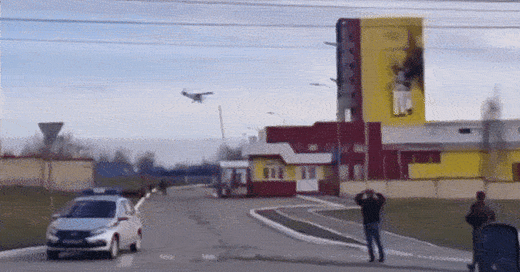Ukrainian Drones Double-Tapped the Factories That Make Parts for Russia's Best Fiber-Optic Drones
The Saransk plants were hit overnight, and in the morning, on April 4 and 5
On the night of April 4, a dozen Ukrainian attack drones motored 460 miles into Russia and struck a fiber-optics factory in the city of Saransk. The next morning, at least one more Ukrainian drone struck another building belonging to the fiber-optics industry in the same city.
It was a double-tap raid targeting critical infrastructure for the production of Russia’s best fiber-optic drones. Further effort by the Ukrainians to get “left of the boom” and counter Russian drones where they’re most vulnerable: on the industrial level.
The overnight raid may have involved explosive attack drones such as all-Ukrainian PD-1s. The daylight raid, captured on video, apparently involved one of Ukraine’s Aeroprakt A-22 sport plane drones. It’s not clear whether it was a single-use A-22, which slams into its target with its explosive payload, or one of the former manned planes Ukrainian engineers have modified to drop bombs.
The there-and-back, bomb-dropping A-22s are multi-use, provided they don’t crash or get shot down. In partially shifting to reusable attack drones, Ukraine increases the number of targets each drone can strike.

Repeated strikes
That’s particularly helpful for high-value targets such as the fiber-optics factories in Saransk, which produce the components—the fibers, repeaters and other subsystems—that make up Russia’s unjammable first-person-view drones. Russia’s other FPVs, steered via radio, are susceptible to Ukrainian electronic warfare.
The double-tap raid on Saransk came just a few weeks after a triple-tap raid on the Russian bomber base in Saratov, in southern Russia 400 miles from the front line in Ukraine. According to the Ukrainian general staff, the third blast on March 20 destroyed 96 Kh-101 cruise missiles—some of Russia’s best munitions for striking Ukrainian cities. The total cost to the Kremlin: around $960 million.
The Saransk raid may not come with a similarly high monetary cost, but it promises to throttle the supply of parts for Russia’s best front-line attack drones, which under the control of skilled operators can peer inside the dugouts that shelter Ukrainian vehicles—and which, unlike radio-controlled drones, are all but impossible to ground mid-flight.
The Saransk facilities are some of the few—reportedly the only, according to some sources—Russian plants producing fiber-optics tech. It’s not for no reason that one Russian blogger complained Russia might now need to “buy it from China.”
Read more:
Ukraine's Drone Force Is Blowing Up the Industrial Infrastructure Supporting Russia's Best Unjammable Drones
On the night of April 4, a dozen Ukrainian attack drones motored 460 miles into Russia and struck a factory in the city of Saransk.






